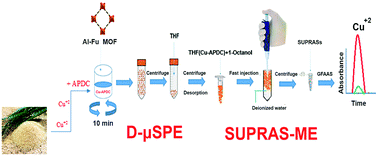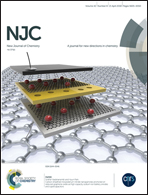Metal–organic framework based micro solid phase extraction coupled with supramolecular solvent microextraction to determine copper in water and food samples
Abstract
A novel analytical method based on the coupling of dispersive micro-solid phase extraction (D-μSPE) and supramolecular solvent microextraction (SUPRAS-ME) has been developed for the extraction and preconcentration of ultra-trace copper in water and food samples. In the hyphenated D-μSPE-SUPRAS-ME, initially copper ions were extracted from a large volume of aqueous sample (100 mL) into a 30 mg aluminum fumarate (Al-Fu) metal–organic framework. After the desorption of the analytes from the sorbent using THF, the desorption solution was used in the SUPRAS-ME method as a dispersant solution. In this way, higher enrichment factors could be achieved. Different parameters were optimized for obtaining maximum extraction efficiency of copper from various samples (water and food sampls). Under the optimal conditions, an enrichment factor in aqueous solution of 280 was obtained. The calibration curve was linear in the range of 0.5–15 ng mL−1 with correlation coefficients ≥0.99. The intra-day reproducibility of the method was satisfactory with relative standard deviations less than or equal to 6.5%. Moreover, the detection limit and limit of quantification were 0.2 ng mL−1 and 0.5 ng mL−1, respectively.



 Please wait while we load your content...
Please wait while we load your content...